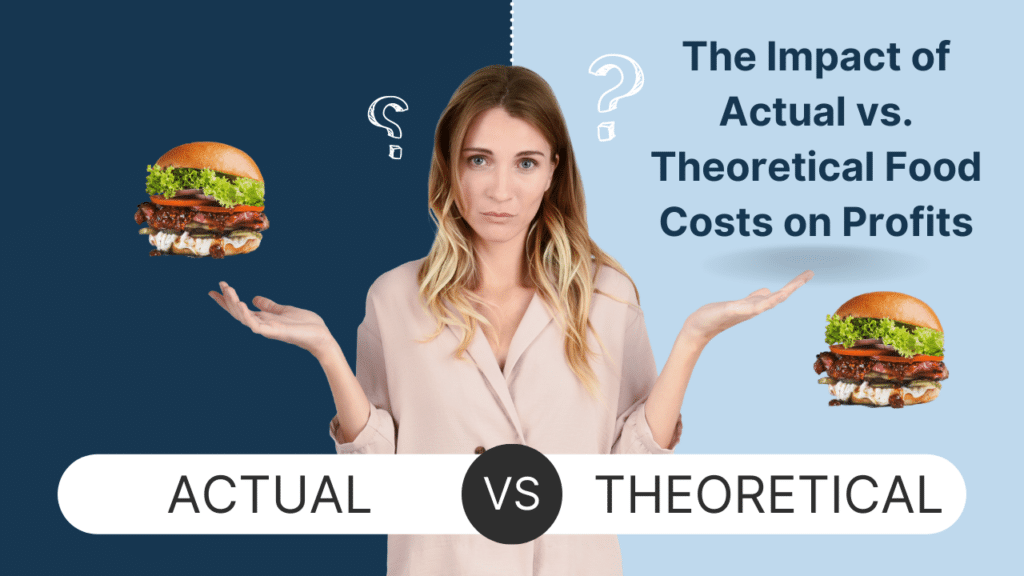The restaurant industry is a dynamic and complex landscape, where profit margins often teeter on a precarious balance. With the average food costs in a restaurant typically hovering around 30%, and global food prices rising at nearly 40% year over year, managing food costs is more critical for restaurants than ever.
One of the key factors influencing profitability is the interplay between actual and theoretical food costs. This intricate relationship underscores the importance of effective cost management and highlights the challenges that restaurateurs face in maintaining healthy bottom lines.
In this article, we delve into actual and theoretical food costs, exploring how their variance can significantly impact profits and the strategies that culinary and restaurant businesses employ to navigate this challenge.
Understanding Actual and Theoretical Food Costs
Before delving into the implications for profits, let’s establish a clear understanding of the terms actual and theoretical food costs:
Actual Food Cost: This represents the tangible cost of the ingredients used in preparing a dish. It encompasses all direct expenses related to the production of the meal, such as purchasing ingredients, storage, and waste.
Theoretical Food Cost: Also known as “ideal” or “standard” cost, this refers to the calculated cost of a dish based on predetermined portion sizes and ingredient costs. It serves as a benchmark for what the price should be under ideal circumstances, assuming no waste or deviations from portion sizes.
The Profit Equation
The relationship between actual and theoretical food costs is an integral part of the profit equation for restaurants. The equation is simple: Profits = Revenue – Costs. However, the subtleties of the food cost component can significantly influence the overall profit margin.
Impact on Profits
Positive Variance: A favorable scenario occurs when actual food costs are lower than theoretical food costs, resulting in heightened profit margins. Achieving this outcome is often a goal for restaurants, indicating effective inventory management, portion control, and minimal wastage.
Negative Variance: Conversely, a less desirable situation arises when actual food costs exceed theoretical food costs, leading to a contraction in profit margins. This discrepancy could stem from inaccurate portioning, wasteful practices, fluctuations in ingredient prices, or unexpected deviations in recipes.
Strategies for Managing Discrepancies
The variance between actual and theoretical food costs requires strategic measures to mitigate its impact on profits. Here are some practical measures that restaurants can adopt:
- Recipe Standardization: Ensuring accurate documentation of recipes and consistent portion control is crucial. Standardized recipes promote uniformity and reduce the potential for cost disparities.
- Inventory Management: Employing robust inventory tracking and management systems can help minimize wastage and control costs efficiently.
- Menu Engineering: Analyzing the profitability and popularity of menu items empowers chefs and managers to make informed decisions regarding pricing and portion sizes. By conducting a meticulous analysis of each menu item’s contribution to overall profitability and popularity, restaurants can fine-tune their offerings. Dishes that boast higher profit margins and are well-received by diners can be strategically positioned to offset items with narrower margins.
- Vendor Relationships: Establishing solid ties with suppliers can lead to favorable pricing terms and a reliable supply chain, contributing to cost containment.
- Technology and Data Analytics: Leveraging Point of Sale (POS) data and data analytics provides real-time insights into ingredient usage, facilitating timely adjustments to portion sizes, pricing, and inventory levels.
Conclusion
The dance between actual and theoretical food costs holds immense significance in restaurant profitability. A clear understanding of these concepts, combined with meticulous cost management strategies, and an up-to-date tech stack with inventory management functionality is imperative for sustaining successful restaurants.
The delicate balance between ingredients, portions, and prices underscores the ever-present challenge for restaurateurs to align their aspirations for culinary creativity with the demands of financial viability. As the restaurant and hospitality world continues to evolve, mastering the art of balancing actual and theoretical food costs remains an ongoing journey toward restaurant financial excellence.
Close the Gap with SynergySuite
SynergySuite offers a comprehensive set of tools to bridge the gap between actual and theoretical food costs and safeguard your profits. Simplify vendor management, gain better control over inventory, optimize your food costs, and more with SynergySuite! Get the insights, data, and tools you need to ensure profitability in each of your individual restaurant locations.
Schedule a demo today to learn more.





